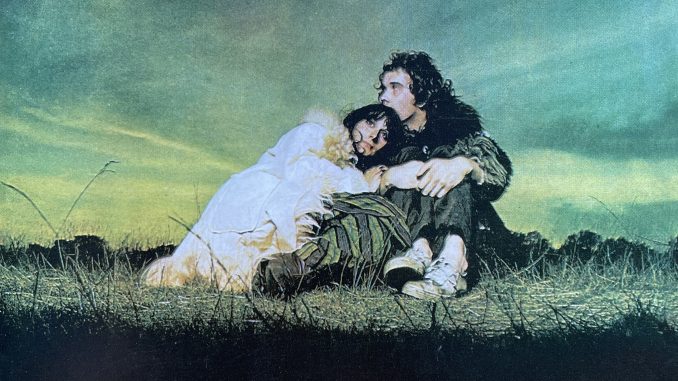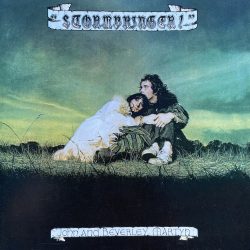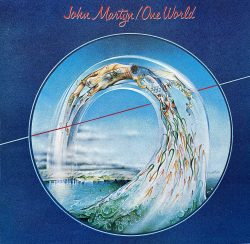
‘But is it Americana’ continues with a passionately argued case from Lyndon Bolton. He’s marshalled his facts and makes a good argument for John Martyn’s early work qualifying as americana; But do you agree?
This series has featured perceptive and well-argued cases for some quintessentially British artists to be viewed through an americana lens but might adding John Martyn to their ranks be a step too far? Undisputedly his improvisations, use of echoplex, wah-wah, and fuzz box made for albums of startling originality. But where is the music of America? Before going any further a substantial qualification is required. The case for John Martyn as americana is restricted to his early output in the 1960s and 1970s, a period when he built a huge reputation from his restless urge to experiment, never allowing himself to be restricted by genre. Spontaneity, always open to all manner of musical influences, Martyn’s records from his debut ‘London Conversation’ released in 1967 through ‘Solid Air’, often cited as his highest regarded album, to his most commercially successful ‘One World’ in 1977, he never fell into a rut. He was always dipping into something new. If americana is defined as roots orientated but created in a world removed from its pure origins then John Martyn’s folk, blues, and jazz fusions should be included.
The most convincing evidence is Martyn’s work with his then wife Beverley, in particular their debut ‘Stormbringer!’ released in 1970. Recorded in Woodstock with, among others, The Band’s Levon Helm whose unmistakable drumming style on the backbeat opens up acres of space for John and Beverley to explore all the ingredients of americana. Their follow-up ‘The Road to Ruin’ would also make it through today’s americana definition.
Thereafter americana featured frequently but into the 1980s and 1990s, Martyn’s albums were slicker and less innovative. Interestingly, his final and posthumous release in 2011 ‘Heaven and Earth’ returns to a simpler style more sympathetic with americana.
From where did these early influences come? Born Iain David McGeachy in New Malden, Surrey in 1948, Martyn grew up in Scotland. Playing the local folk club circuit Martyn soon met musicians who would make a great impact on his style. A massive influence was his teacher, Hamish Imlach, who suggested blending the Gaelic folk styles with elements of ragtime, blues, and country. Incredible String Band founder Clive Palmer made a similarly deep impression as did Davey Graham who was one of the first musicians to properly experiment mixing up the very separate worlds of folk, blues, and jazz. Replacing the Scottish for the London folk scene McGeachy became John Martyn (named after his favourite make of guitar but with a ‘y’).
For his debut, Martyn stayed mostly within the boundaries of his by now familiar folk surroundings. Opener ‘Fairy Tale Lullaby’ from ‘London Conversation’ is an intimate and touching introduction to Martyn’s writing. But interpreting a couple of more traditional sources and a Dylan cover suggests more distant horizons. Island Records founder Chris Blackwell saw in Martyn potential beyond the folk scene similar to another of his signings Fairport Convention. ‘Run Honey Run’ definitely stretches the traditions of these islands over to Appalachia. Martyn slips into ‘Cocain’, an old traditional song via the Reverend Gary Davies, with the ease of a delta bluesman.
In 1968 Martyn released his second album, ‘The Tumbler’. Described as the “album that refuses to conform” flautist Harold McNair introduced a strong element of jazz improvisation, his Jamaican roots opening Martyn’s eyes to further dimensions. ‘Dusty’, ‘Fly On Home’ and the dark, gothic, ‘The Gardeners’ demonstrate a relentless curiosity to try new styles. ‘Goin’ Down to Memphis’ shows Martyn becoming increasingly at home down on the porch. “Now when I woke up this morning/ My wife she done drive me from the door”, he wails to fast country blues picking.
Where John Martyn would most certainly be considered americana had the term been in use back then is on his two albums with wife Beverley. Of course, just because they recorded ’Stormbringer!’ in Woodstock does not make the music americana. But unless they had done so in total isolation they could not avoid the influences that saturate ‘Music From Big Pink’ made right there two years previously. Common to that album, considered by many as the beginnings of the genre, was Levon Helm. ‘Stormbringer!’ has layers of the country, blues and folk that define americana.
What propelled a British artist with his folk leanings in such a direction? It is not unreasonable to suggest that an artist with Martyn’s appetite for new ideas and absorption of influences from so many sources would want to explore American roots. Perhaps more influential was Beverley Kutner who he met in 1969. Another regular on the London folk circuit and friend of Paul Simon who got her a slot at the 1967 Monterey Festival, Beverley had been looking for musicians to work with her on a solo album on Joe Boyd’s Witchseason Productions. Within the year she and Martyn were married and recording together in London. The following year they were in Woodstock writing new material which, produced by Boyd, they recorded in New York. Helm’s signature drumming style rings through ‘John the Baptist’ and ‘Would You Believe Me’, two songs that roll with The Band’s relaxed mix of American roots. The latter saw the debut of what was to become Martyn’s own signature, his echoplex. Curiously, none of the songs was jointly written. Beverley’s ‘Sweet Honesty’ rolls along with a bluesy swagger, her vocals sounding very American. Opener ‘Go Out and Get It’ is a humming introduction to all the American musicians on the album.
Released later that year, ‘The Road to Ruin’ showed just how John Martyn liked spontaneity and Joe Boyd did not. From the Woodstock roots of Dylan and The Band Martyn returned to London and rich with sax, more jazz improvisation followed as he began his long partnership with bassist Danny Thompson. Amid all that jazz stood out some songs that feel more at home on their previous album, such as the rollicking country blues John and Beverley wrote together, ‘Sorry To Be So Long’ whereas ‘New Day’ and ’Tree Green’ have folkier roots. If they shared the Americana mantle on ‘Stormbringer!’ Beverley was its champion on ‘The Road to Ruin’ with her vocal versatility. From country through folk to blues and soul, she could do it all. And to think that was the end of her recording career for 28 years.

‘Bless The Weather’ came next in 1971. Island encouraged John to record solo which he did reluctantly although he did rate ‘Bless the Weather’ as “the purest record I ever made”. With perhaps more emphasis on the precision of the songs, a roots Americana is less evident although the record today would probably enter the singer/songwriter ambit.

For many, Martyn reached his peak creativity on ‘Solid Air’ in 1973. As with most of its predecessors, he recorded it in a matter of days, all the more incredible given his continual experimentation. The americana trail does weaken somewhat with all the loops and echoplex. If his version of Skip James’s ‘I’d Rather be The Devil’ is a masterpiece of improvisation, it still retains its visceral blues roots. ‘Over The Hill’ and the widely covered ‘May You Never’ are light jaunty pieces in stark contrast to the title track, a searching look into Nick Drake’s mental troubles. Vocally Martyn switches from folk into a dark bluesy brooding. The delicate acoustic picking and drawn-out vocals of ‘Go Down Easy’ could easily place him in Laurel Canyon. ‘Dreams By The Sea’ reverberates with the looping riffs interspersed with jazz keys and sax. ‘The Easy Blues’ switches back to classic blues. Straight from the Delta Martyn pleads, “Mister jelly roll baker/ Can I please be your slave?” ‘Solid Air’ deserves its ranking in the Martyn canon for its complete sweep of the myriad styles from his catalogue to date.
Thereafter, evidence of americana becomes less plentiful. Martyn described ‘Inside Out’, also from 1973, as “everything I ever wanted to do in music… it’s my inside coming out.” Again recorded as swiftly as to be almost live the greatest impression is of deep introspection. Yet ‘Fine Lines’ returns to the west coast, while the traditional ‘Eibhli Ghail Chiuin Ni Chearbhaill’ is given the Martyn treatment, ‘So Much in Love With You’ carries on that raw improvisation.
Perhaps the best of Martyn’s singer/songwriter output comes on ‘Sunday’s Child’. Throughout runs a sense of contentment that sums up his family life at the time. ‘One Day Without You’, ‘Lay It All Down’, ‘Sunday’s Child’ all exude so much love. ‘My Baby Girl’ and ‘Spencer the Rover’ are both besotted daddy whose pop narrowly avoids getting too gooey. The Americana gem comes last, ‘Ellie Rae’ is a haunting glimpse into a Tennessee world of cruelty and loss.

Nearly there. After a live album and a compilation, Martyn rounded off the decade’s studio recordings in 1977 with his greatest commercial success, ‘One World’. In contrast to his previous recordings done in very few takes ‘One World’ shimmers with luscious production, creativity, painstaking detail and determination. Most of the tracks were recorded between 3am and 6am in a mobile studio parked on an island in the middle of a lake. The relentless loops, light sax that flow into cascades of sound on ‘Dealer’, ‘Smiling Stranger’ and ‘Big Muff’ made this so memorable. More like americana, ‘Couldn’t Love You More’ and ‘Certain Surprise’ reflect a very 70s singer/songwriter vibe in their intimacy. ‘Small Hours’ floats across that lake during those small hours in beautiful ripples of sound, instrumentally, technically and vocally.
Martyn’s 1980s and 1990s releases were far less experimental, concentrating more on refining the techniques of ‘Solid Air’ and ‘One World’. Moving much further on, ‘Heaven and Earth’, featured many old friends including Levon Helm, Jim Weider and Garth Hudson. Released two years after he died in 2009 this final album would certainly pass americana muster. ‘Heel of the Hunt’ and ‘Bad Company’ are soaked in pulsating electric guitar, menacing rhythm and rasping vocals though he does soften with ‘Gambler’ and the profoundly sad ‘Can’t Turn Back the Years’.
But Is John Martyn americana? Yes, but only in those formative early days, the result of his absorption of so many influences and his own creativity. If those records came out today AUK would surely say yes, this is americana. So old fans, rethink and revisit. If you haven’t come across John Martyn, have a go. For maximum pleasure listen to the re-released versions with alternative mixes, many of which add heft to the americana argument. But that’s another story because, in the end, does it really matter what it is called?



John Martyn both defies and transcends categorisation. Just listen to his music.
As you conclude does it matter! However, the answer is yes.